Content:
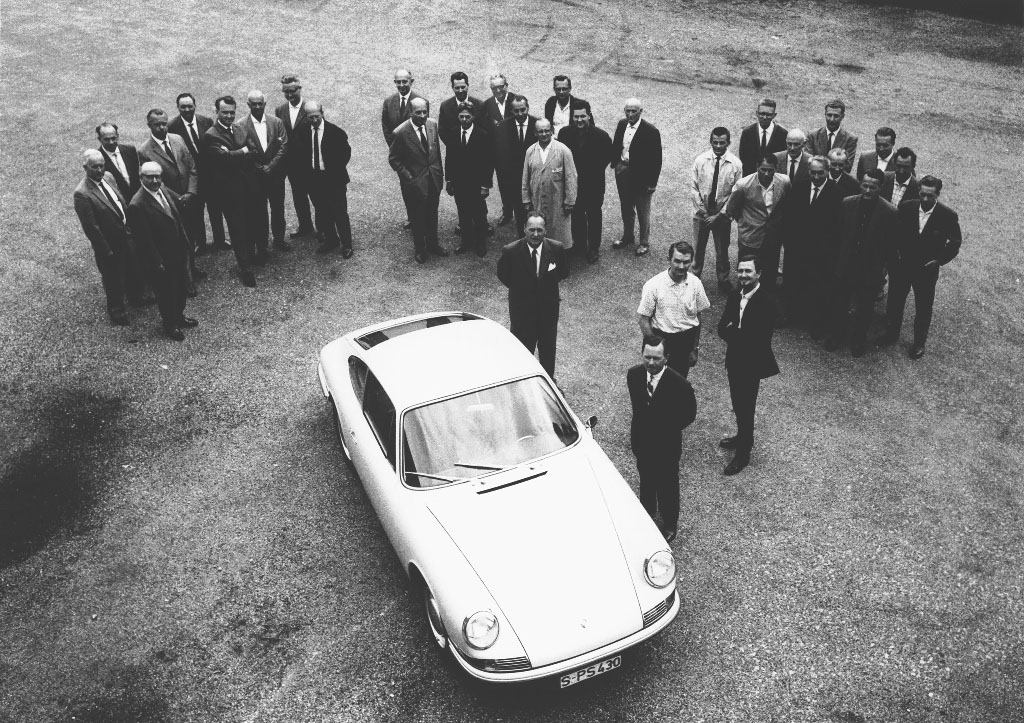
Forty Years of the Porsche 911 (Short Story)
The Cutting Edge in Technology for Four Decades
The “911" as its drivers and fans call it is celebrating its 40th birthday: Four decades of Porsche sports car tradition, with new, trendsetting variants entering the market time and again. And there is absolutely no reason to believe that the thrilling 911 story will lose its momentum in the next years or even decades. On the contrary, the 911 will continue to play a decisive role in keeping Porsche economically healthy and independent, acting as a key element in the Company's plans for the future.
Production of the 911 in the 2002/2003 year of business exceeded 25,000 units. Intelligent, far-sighted technical development of the 911 (together with the Porsche Boxster) is indeed the reason why Porsche, following difficult times in the early '90s, has in the meantime risen to new heights, remaining an independent car maker of the highest standard. Increasing consistently throughout the last 10 years, production, customer deliveries, revenues and profits have moved up from one record to the next. And now, not least thanks to the introduction of the Cayenne, this story of success will continue in the 2002/2003 year of business despite the difficult market and world economy.
Back in 1963 Porsche was a small company with some 1,000 employees. The launch of the 911 at the Frankfurt Motor Show was a great and, indeed, a dramatic milestone for this sports car manufacturer from Stuttgart-Zuffenhausen.
The basic concept of this sports car presented by Porsche for the first time remains almost unchanged to this very day: The high-performance power unit fitted in the rear of the car gives the 911 superior agility, optimum brake behaviour and good traction on the rear wheels.
The design of the car goes back to Ferdinand Alexander Porsche, the eldest son of Ferry Porsche, at the time the President and Chief Executive Officer of the Company. A 25-year old designer back in those days, F. A. Porsche warmly remembers the great task of creating a successor to the Porsche 356: “The job was not to simply design some kind of new car within a large model range. No – this was to be the successor to a car which itself had become a classic after more than 1 1/2 decades in the market." So he himself describes the 911 as a sports car with a clear and honest form, stating just as clearly that “a good product must be discreet in its good looks. Design is not fashion".
Back then and today, the power unit of the 911 was and is a horizontally-opposed six-cylinder with an unmistakable sound, even though output has increased to 320 bhp in the current Carrera or even 420 bhp in the 911 Turbo. A decisive year in this development process was 1997, when Porsche developed a new power unit for the 911 retaining only the principle of the horizontally-opposed six-cylinder. For the big difference was that this 3.4-litre power unit initially developing 300 bhp was – and is – water-cooled. The concept of air cooling applied up to that time on the VW Beetle and later on all 356 and 911 models was no longer suitable mainly because of the optimum cooling required on all four valves of each cylinder. And ever since the introduction of water cooling, it has been much easier to fulfil the strict emission standards now applicable worldwide. Today the six-cylinder in the 911 Carrera develops a maximum output of 320 bhp from 3.6 litres.
Essential features demanded not only of the 911, but also of its predecessor, the 356, are that a Porsche sports car must be reliable and fast, but at the same time fully suited for everyday motoring, socially accepted, and with lasting qualities guaranteeing lasting value. These principles applied from the very beginning remain unchanged to this day: Throughout the last four decades, the 911 has remained modern, the cutting edge in technology in many areas, and therefore often a step ahead of its times.
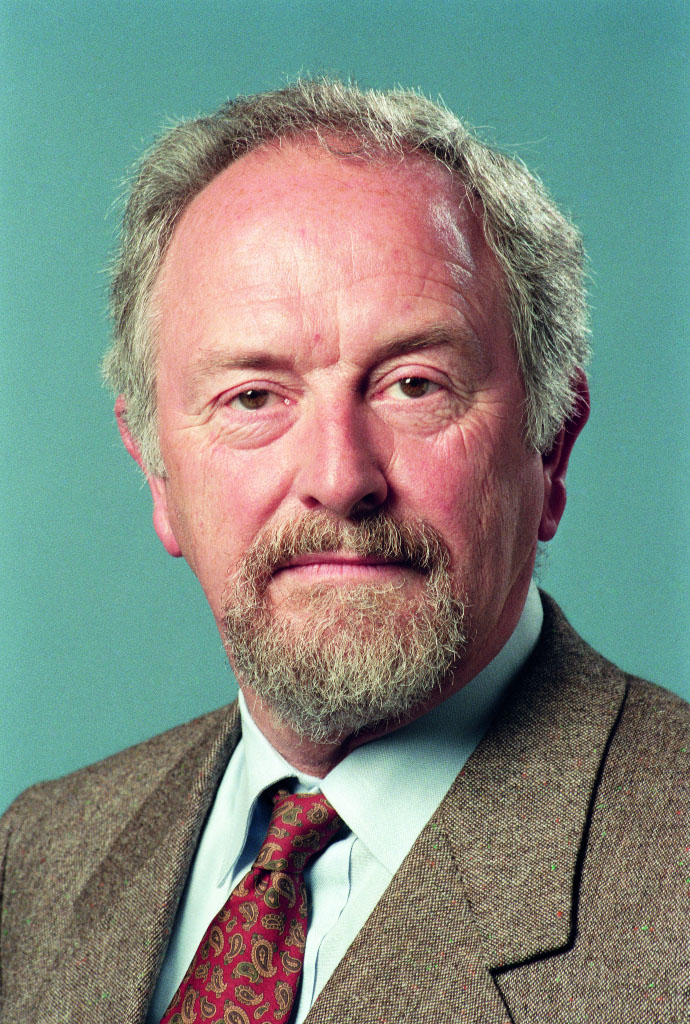 The 928 – the car initially seen as the successor to the 911
The 928 – the car initially seen as the successor to the 911
Back in the mid-70's this superiority of the 911 was not acknowledged by everybody. Indeed, there were certain doubts within the Company as to the long-term perspectives of the Porsche 911. So in autumn 1977 Porsche presented the 928, a front-engined 8-cylinder sports car claimed to be the new top-of-the-range model and the upcoming successor to the 911. Although the 928 was clearly acknowledged for its qualities, customers remained loyal to the 911. And even though Porsche's engineers kept on upgrading the 928 for many years, they slowly but surely started to focus more on the process of optimising the immortal 911 in all its glory.
Right from the start, the 911 was truly outstanding in its supreme performance – and this supremacy remains a characteristic feature of this unique sports car from Stuttgart-Zuffenhausen to this very day. Back in 1963, superiority of this kind meant acceleration from 0 – 100 km/h in 9.1 seconds and a top speed of 210 km/h or 130 mph. By contrast, the current 911 Carrera in the 996 model series accelerates to 100 km/h in 5.0 seconds and has a top speed of 285 km/h or 177 mph.
The Porsche 911 also plays an outstanding role in the Company's history of motorsport which contributed so significantly to the image of the 911 and vice versa. Whilst it would be wrong to say that the 911 is responsible for all of Porsche's racing wins scored on race tracks and in rallies the world over, it is a fact that more than half of the well over 23,000 victories in Porsche's motorsport career are attributable to the 911.
First try – first win: This was in 1965 when two employees of Porsche – Herbert Linge and Peter Falk – brought home a class victory as “insignificant" outsiders in the Monte Carlo Rally with a 130-horsepower 911, finishing fifth overall. Only a short while later, in the years from 1968 – 1970, the winners of the Monte Carlo Rally, Elford/Stone and Waldegård/Helmer clinching victory twice in their 911, had more power increasing to 230 bhp by the year 1970.
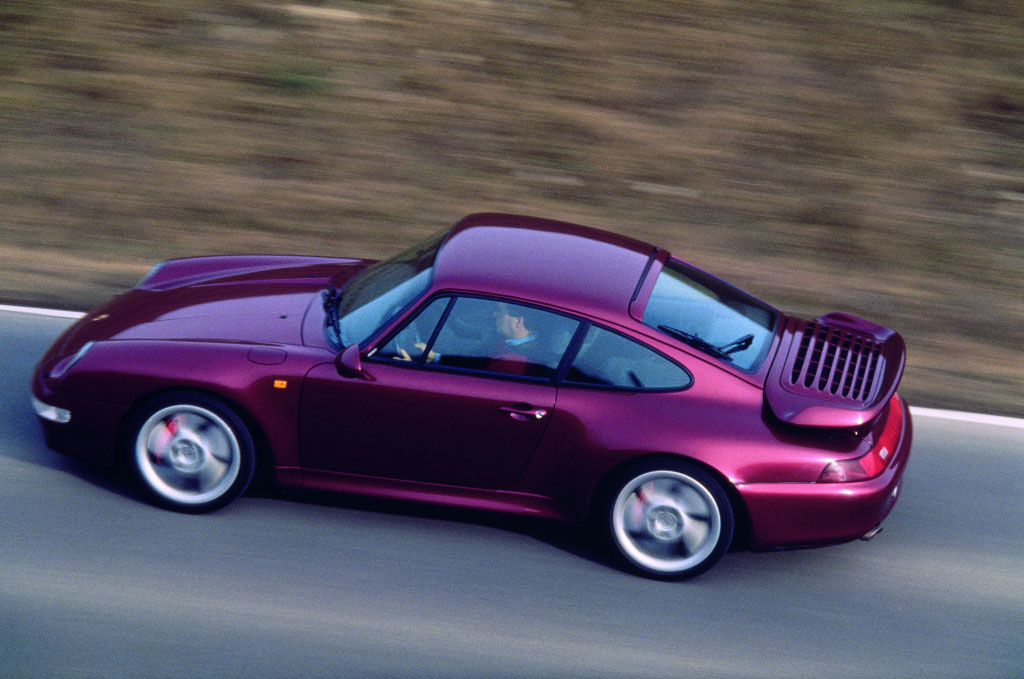 Power rockets up to 845 bhp
Power rockets up to 845 bhp
Aficionados of sports cars will definitely have wonderful memories of the 911 Carrera RS 2.7, which entered production in autumn 1972. This car was the starting point for a wide range of 911s with outstanding racing attributes such as the Carrera RSR. The first Turbo Carrera developing 500 bhp entered the scene in 1974, paving the way for the 934 and 935 specially built for the new Group 4 and Group 5 production sports car category raced as of 1976 according to new international regulations. Right from the start, these cars won the Constructor's World Championship for Porsche, Rolf Stommelen/Manfred Schurti and Jochen Mass/Jacky Ickx bringing home this glorious victory. In 1977 an optimised 935 won three races for the Constructor's World Championship, private 935s clinching the title for Porsche. And in 1979, finally, a 935 won the 24 Hours of Le Mans.
The most extreme racing version of the 911 was “Moby Dick" in 1978. Low, wide and long, this Porsche clearly stood out from all other versions of the 935 at first sight. For the first time in the history of the 911, the engine came with water-cooled cylinder heads featuring four valves per cylinder. Output of the turbocharged 3.2-litre six-cylinder peaked at a staggering 845 bhp.
The 911 GT1 introduced in 1998 was the first Porsche to feature a carbon-fibre chassis, the absolute highlight of the year being Porsche's one-two victory in Le Mans with Allan McNish/ Laurent Aiello/Stephane Ortelli finishing first ahead of Uwe Alzen/Bob Wollek/Jörg Müller.
By tradition, customer sport has always been of great significance to Porsche – and the 911 is acknowledged as an excellent racing car also for the customer. Raced by a customer team, a 435 bhp 911 GT3 RS brought home the 24 Hours of Daytona in the USA in February 2003. 911 GT3 Cup cars closely related to their production counterparts and developing output of approximately 390 bhp are to be admired all over the world in various Porsche brand trophies, Porsche customers currently winning international and national Gran Turismo titles with this series-based 911.
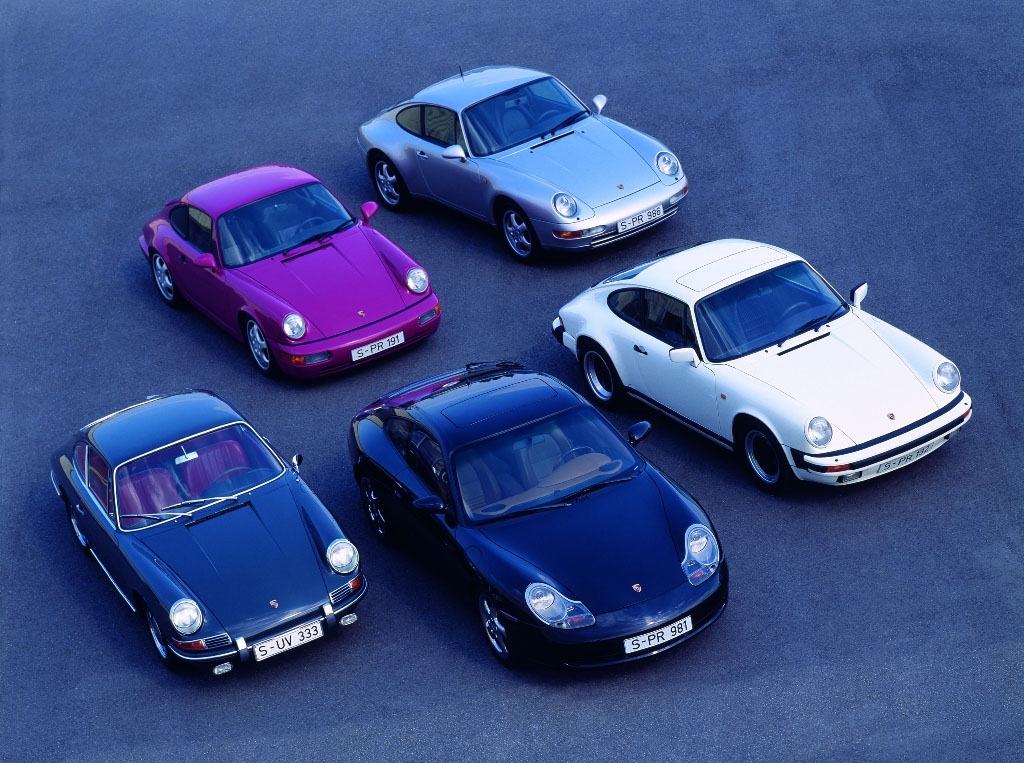
Forty Years of the Porsche 911
Milestones
1963
The Porsche 901 is presented at the Frankfurt Motor Show, later to be re-named the 911.
Succeeding the Porsche 356 selling very successfully in the market at a total volume of
approximately 78,000 units, the 911 was designed by Ferdinand Alexander Porsche, the eldest
son of Porsche President Ferry Porsche. Distinguishing features setting the new model aside
from the 356 were extra space inside, a higher standard of driving comfort, and, for the
first time, a six-cylinder replacing the four-cylinder. Major factors remaining unchanged were
the engine mounted at the rear, once again an air-cooled horizontally-opposed power unit.
1964
The 911 goes into production, initially at a retail price of DM 21,900.–. Maximum output is 130 bhp, top speed 210 km/h or 130 mph.
1965
Demand for a low-cost Porsche leads to the 912 with its power unit carried over from the 356 model series. Fitted in the Porsche 912, this engine develops maximum output of 90 bhp. The level of equipment was also scaled down versus the 911, giving the 912 a retail price of DM 16,250.–. The Targa is presented in early September 1965, a new body variant with a rollbar fitted in position, a removable roof and, initially, a folding PVC rear window.
Racing the 911 for the first time, Porsche engineers Herbert Linge and Peter Falk finish fifth in the Monte Carlo Rally
1966
The 100,000th is delivered to its proud owner on 21 September – the owner of this Porsche 912 happening to be the police. The two-litre six-cylinder receives its first power boost, hailing the introduction of the 160 bhp 911 S with a top speed of 225 km/h or 140 mph. The suspension is optimised by the addition of anti-roll bars front and rear, a further new feature being forged light-alloy wheels with rims varying in size. Designed by Porsche's Styling Studio, these rims are made by Fuchs in Germany, “Fuchs rims" having a great name to this very day as the most typical of all Porsche wheels. In racing trim, the two-litre power unit develops 210 bhp and is fitted in both the Porsche 904 and the Carrera 6 (906). Racing this latter model, the Carrera 6, Mairesse/Müller win the 50th Targa Florio in Sicily in 1966.
1967
The Porsche 911 T priced at just under DM 20,000.– enters the market for the 1968 model year, soon replacing the 912. Maximum output of the six-cylinder power unit is 110 bhp, and the car is fitted with a four-speed gearbox. The anti-roll bars are dropped on this “low-budget" model. Sportomatic becomes available for the first time, a semi-automatic four-speed transmission with a fluid torque converter and a clutch engaged and disengaged electrically every time the driver moves the gearshift lever. Sportomatic remains in production until 1980. Another new member of the 911 model family is the 911 L developing 130 bhp and sharing the same features as the 911 S. Racing a Porsche 910, Buzetta/Schütz bring home Porsche's first overall win in the 1000 Kilometres of the Nürburgring.
1968
Wheelbase on all 911 models is extended from 2211 to 2268 millimetres. Elford/Stone lead over Toivonen/Tiukkanen in a sports version of the 911 T to score a one-two victory in the Monte Carlo Rally. From now on the Targa is fitted with a firm glass window at the rear.
1969
Engine capacity is increased to 2195 cc for the new model year, the 911 T, E and S now developing maximum output, respectively, of 125, 155 and 180 bhp. Waldegård/Helmer win the Monte Carlo Rally in both 1969 and 1970.
1971
Another increase in engine size, this time to 2341 cc. Output of the three 911 T, E and S models increases again, this time moderately, to 130, 165 and 190 bhp. A particular feature is that all engines are now able to run on regular fuel on account of stricter emission standards, with high-octane fuel containing a large amount of lead no longer being available in some export markets.
1972
The Carrera model designation appears for the first time on the Porsche 911. In Carrera trim, the 356 featured the then new, extra-powerful vertical shaft engine. The name itself comes from Carrera Panamericana, a road race through Mexico back in the '50s. With engine power of 210 bhp, the 911 Carrera 2.7 becomes the fastest road-going car in Germany with a top speed of 245 km/h or 152 mph. Its characteristic feature, of course, is the “ducktail" at the rear.
1973
Now the other power units in the 911 model range are also beefed up to 2.7 litres, the Carrera RS being modified for motorsport and winning, in RSR trim, the 24 Hours of Daytona and the 12 Hours of Sebring, both in the USA. Another RSR entered in the prototype category due to its extra-wide wheel arches wins the last Targa Florio, the great race in Sicily where Porsche had won its first race for the Constructor's World Championship with the 550 A back in 1956.
1974
Porsche presents the first series sports car in the world with an exhaust gas turbocharger, the 260 bhp 911 Turbo. The RSR is also boosted by turbo power, 500 bhp in a car derived from its series counterpart giving Porsche outstanding success against the most exotic prototypes.
1975
As a result of the Long-Term Car Research Project, Porsche becomes the first car maker in the world to use steel body plates hot-galvanised on both sides. This allows a six-year warranty against rust perforation extended in 1985 to 10 years.
1976
In its very first season, the Porsche 935, a racing model prepared for Group 5 specifications at the time, goes from one victory to the next. The 935 wins the World Championship in both 1976 and 1977 and is raced successfully by numerous private teams well into the '80s.
1977
A 911 S 2.7 coming off the production line on 3 June is the 250,000th Porsche since the beginning of production in 1948. One of Porsche's particular strengths is superior fuel economy, Bosch K-Jetronic reducing fuel consumption on the 911 SC (3.0 litres/180 bhp) by 17 per cent versus the former model. Output of the 911 Turbo 3.3 is increased to 300 bhp.
1978
The year of the most powerful 911 ever: Moby Dick, a racing model built in 1978, features a turbocharged 3.2-litre six-cylinder with four overhead camshafts developing 845 bhp!
1979
The Porsche 911 becomes the first high-performance sports car to be fitted in US trim with a fully controlled catalytic converter. In the same year a Porsche 935 raced by Team Kremer from Germany wins the 24 Hours of Le Mans.
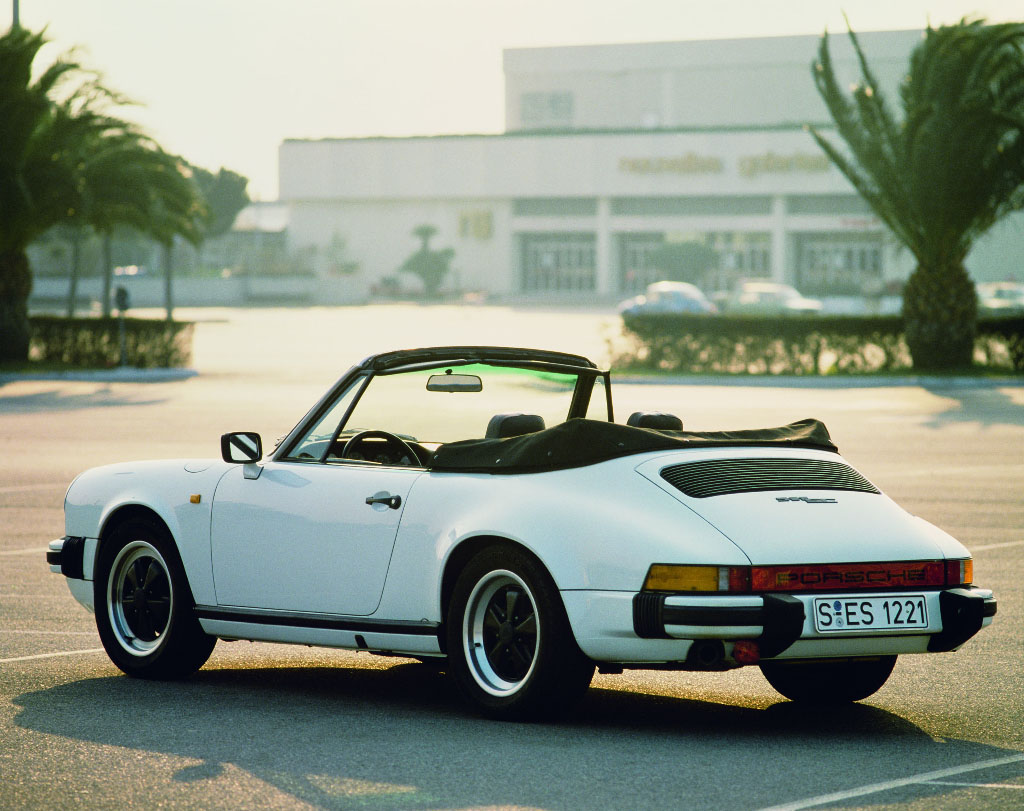 1982
1982
The 911 enters the market for the first time in Cabriolet guise.
1983
A Group B technology study is presented at the Frankfurt Motor Show, ultimately leading to the Porsche 959. The 911 receives the additional name “Carrera", output of the 3.2-litre power unit increasing to 231 bhp thanks to Bosch Motronic
1984
The 911 SC 4x4 wins the Paris-Dakar Rally.
1985
Porsche's most powerful series model so far, the 959 featuring electronically controlled four-wheel drive and register turbocharger technology, enters the market. Porsche introduces catalyst technology also in Germany
1986
The 959 Paris-Dakar wins the toughest Paris-Dakar Rally so far, covering a distance of no less than 13,800 kilometres or 8,570 miles.
1987
The Porsche 959, a kind of “super-911" with avantgarde technology, enters the market as an ultra-high-performance sports car for the road. Selling at a price of DM 420,000.–, the 959 sees a production run of 292 units. The Porsche 911 Speedster is presented at the Frankfurt Motor Show, 2,100 units being built in a special series
1988
Porsche presents the 911 Carrera 4 marking the 25th birthday of the 911 and featuring 85 per cent new components all round. Within the Company, this model series receives the code name 964. For the first time, Porsche offers all-wheel drive to customers in general, the air-cooled six-cylinder displacing 3.6 litres and developing maximum output of 250 bhp.
1989
Marking the 80th birthday of Professor Ferdinand – “Ferry" – Porsche, the Company presents the new Carrera “964" as a Carrera available also without four-wheel drive. Another new feature is Tiptronic with two gearshift lanes for either automatic or manual gearshift.
1990
The Porsche Carrera Cup enters its first season.
1991
After a short break, the Turbo is back again, this time developing maximum output of 320 bhp. A special series of the Carrera RS goes into production, with a total run of 2,391 units.
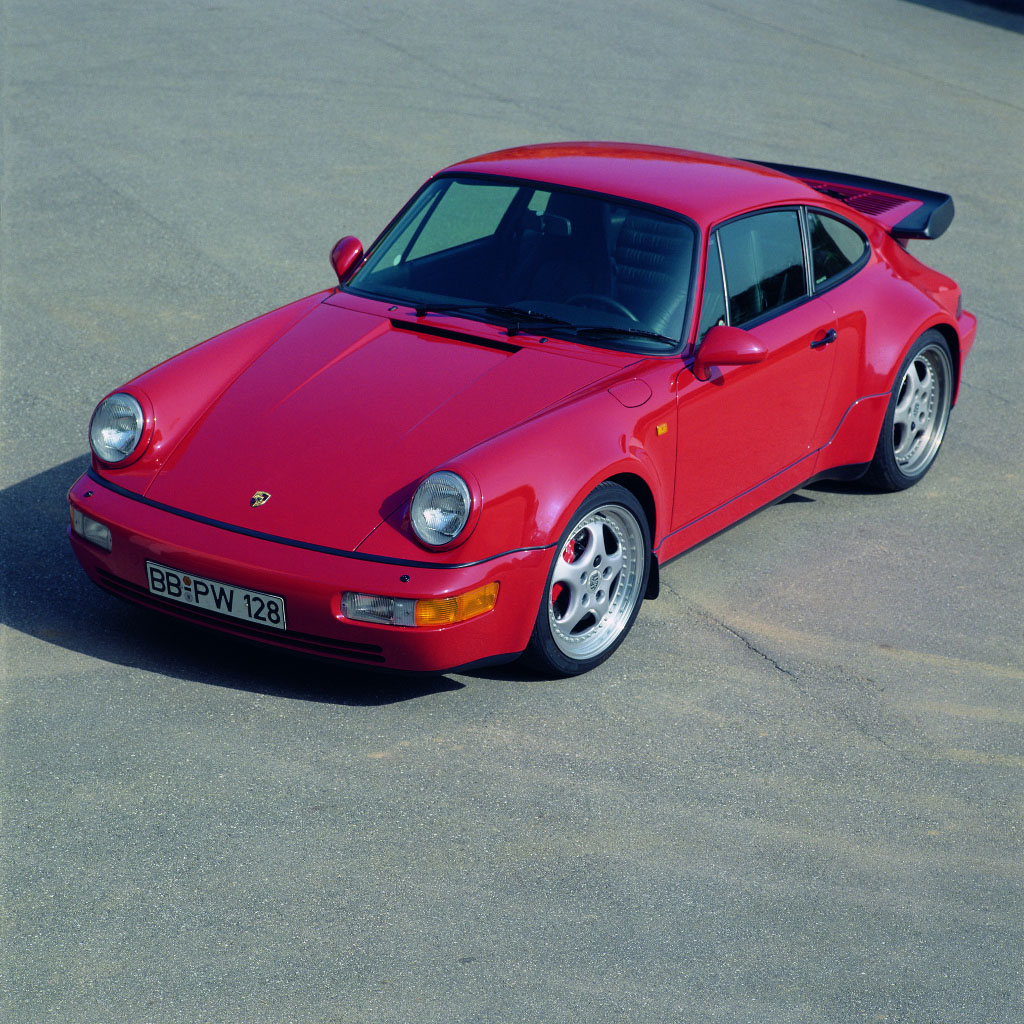 1992
1992
The 360 bhp 911 Turbo 3.6 enters the range. The Turbo defends Porsche's title against 7 other manufacturers in the US Supercar Championship, ultimately beating the most powerful production sports cars in the world.
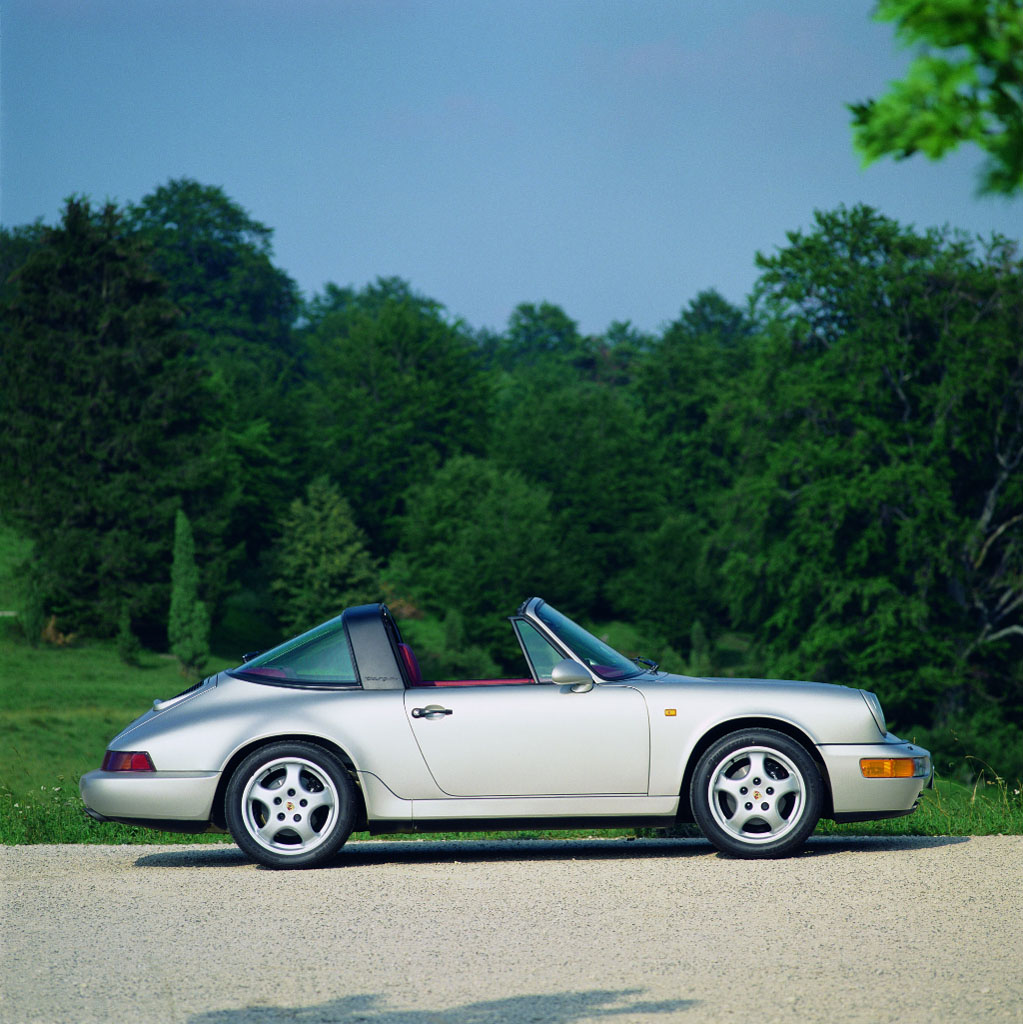 1993
1993
Another new generation of the 911 enters the market: the 993 with a rounder and more muscular body. Beneath the wider rear end, the air-cooled 3.6-litre six-cylinder now develops 272 bhp. Top speed is 270 km/h or 167 mph. The Porsche-Pirelli-Supercup is held for the first time on the occasion of European Grand Prix races.
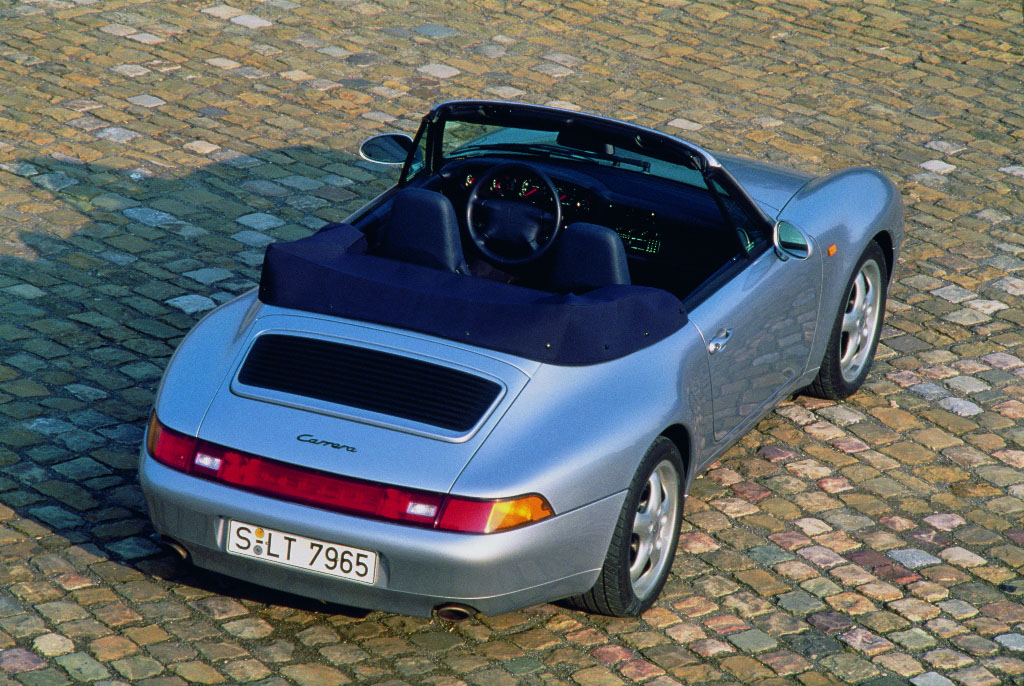 1995
1995
The Turbo makes yet another comeback, this time in the guise of the 993. Fitted with two turbochargers for the first time, the 3.6-litre six-cylinder now develops maximum output of 408 bhp. The first GT2 also enters the market this year as a special lightweight version of the Carrera for road use and racing, with maximum output from its turbocharged engine ranging from 430 – 600 bhp. A Targa also re-appears after a few years, the car now being a 911 Carrera with an extra-large glass roof. And there is even an extremely sporting Carrera RS joining the range once again.
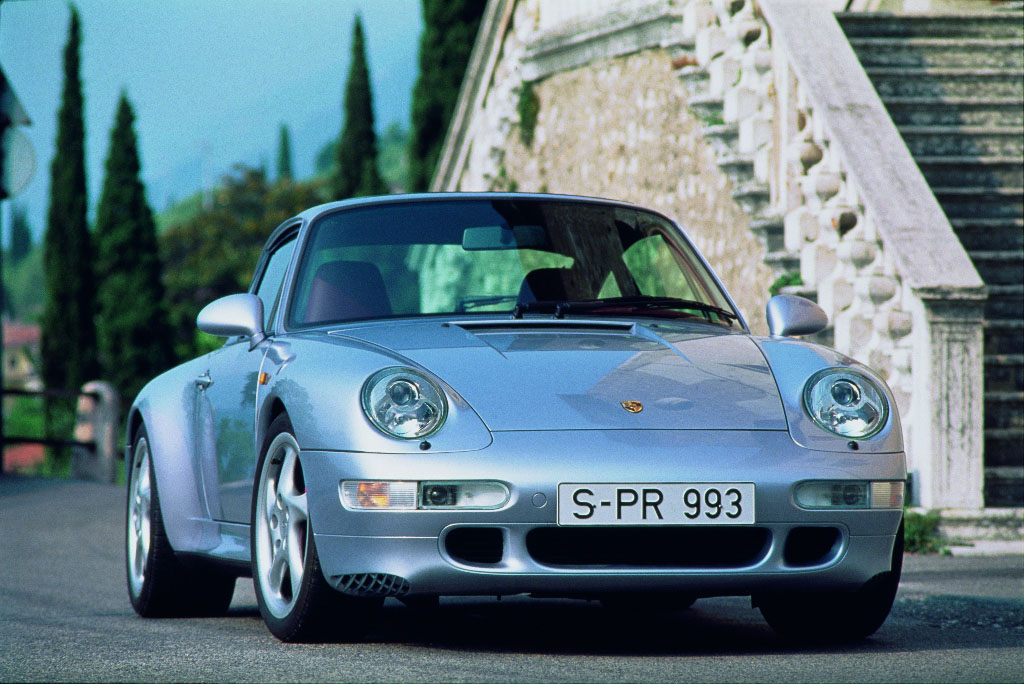 1996
1996
The 911 GT1 enters the racing scene, scoring three wins in three races. Since a road-going version is required for homologation in motorsport, Porsche builds a small series with a 3.2-litre turbocharged engine developing 544 bhp. Top speed is 310 km/h or 192 mph.
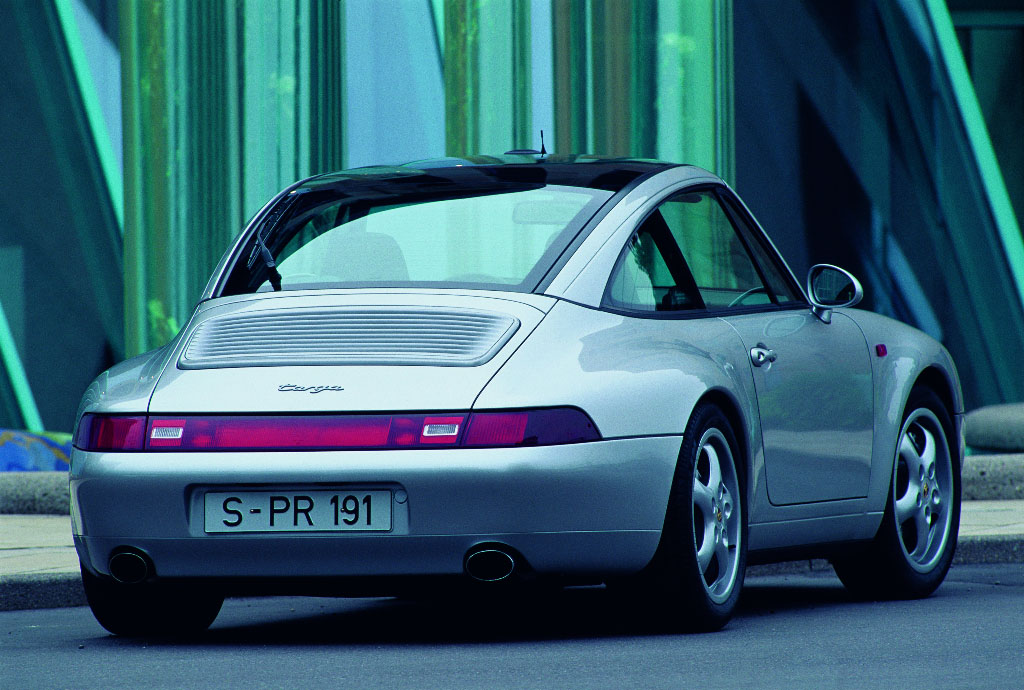 1997
1997
The 1998-version of the Porsche Carrera, the 911 code-named 996 within the Company, exceeds all existing dimensions. This applies, quite literally, to the car's dimensions outside and inside now much larger than before, as well as its technical features. This is also the first 911 powered by a newly developed, liquid-cooled six-cylinder developing maximum output of 300 bhp.
1998
The Company celebrates its 50th birthday as a manufacturer of Porsche cars. In Le Mans the 911 GT1 brings home a one-two victory against the toughest competitors, and in spring the 911 Cabriolet is introduced in the market.
1999
Two-time World Rally Champion Walter Röhrl makes the new 911 GT3 immortal, lapping the 20.8-kilometre Northern Circuit of Nürburgring in 7:56.33 minutes. Never before has a series sports car with normal road tyres homologated for the road covered the most demanding racing circuit in the world this fast.
2000
The 911 Turbo now develops maximum output of 420 bhp, accelerating from 0 – 100 km/h with manual gearbox in 4.2 seconds.
2001
The GT2 rounds off the power range to the top, with its engine based on the race-proven unit already featured in the 1998 911 GT1: The water-cooled flat-six biturbo develops maximum output of 462 bhp from 3600 cc. Maximum torque of 620 Nm or 457 lb-ft, in turn, comes in a broad speed range between 3500 and 4500 rpm. Top speed is 315 km/h or 195 mph.
2002
Engine output of the 911 Carrera increases to 320 bhp, engine capacity is now 3.6 instead of 3.4 litres. The body of the car is slightly modified and, after a break of four years, Porsche once again presents a 911 Targa featuring a glass roof. Another new model is the Carrera 4S combining the normal-aspiration Carrera engine with the special body design of the 911 Turbo
2003
The GT3 is back again, this time with maximum output of 381 bhp. Acceleration from 0 – 100 km/h is in 4.5 seconds, top speed is 306 km/h or 190 mph. Launching the 911 Carrera 4S Cabriolet and the 911 Turbo Cabriolet, Porsche presents further variants of the 911, and the 911 GT3 RS serves as the “basic" model for future activities in motorsport, with 200 units planned for the market as road-going versions.
.jpg)










.jpg)
.jpg)


